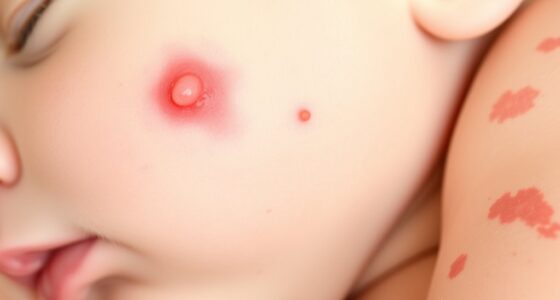To protect your baby or toddler’s delicate skin outdoors, dress them in lightweight, long-sleeved shirts with UPF fabric, and top off with a wide-brimmed hat and sunglasses. Apply broad-spectrum sunscreen generously, reapplying every two hours, especially after swimming or sweating. Schedule outdoor play during early morning or late afternoon, and seek shade under umbrellas or trees. Stay vigilant for signs of sunburn, keep them well-hydrated, and use shade structures to ensure safe, sun-smart fun. Keep exploring these tips for more protection ideas.
Key Takeaways
- Dress babies and toddlers in UV-protective, tightly woven clothing and wide-brimmed hats to shield sensitive skin outdoors.
- Schedule outdoor activities during early morning or late afternoon to avoid peak UV hours.
- Use broad-spectrum, mineral-based sunscreens generously and reapply every two hours or after water exposure.
- Provide shaded areas with umbrellas, trees, or portable tents to minimize direct sun exposure during play.
- Keep children hydrated and cool with frequent drinks, shade, and cooling cloths on hot days to prevent heat-related issues.
Choosing the Right Clothing for Sun Protection
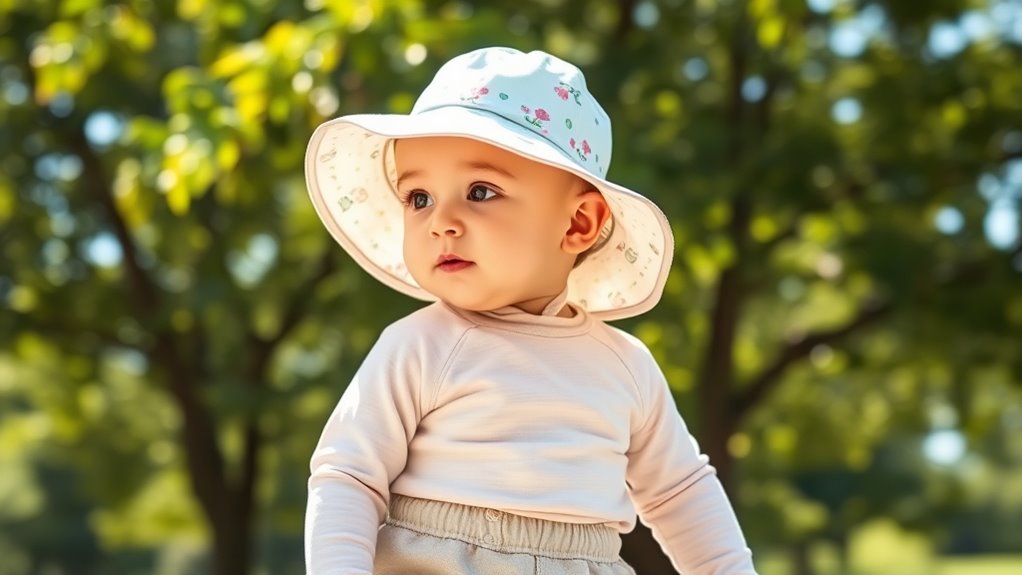
When it comes to protecting your baby or toddler from the sun, choosing the right clothing is essential. Look for clothing with built-in UV protection, which offers an extra layer of defense against harmful rays. Clothing materials matter—opt for tightly woven fabrics like cotton or special UPF-rated fabrics designed for sun safety. Lightweight, long-sleeved shirts and wide-brimmed hats help cover sensitive skin without causing discomfort. Avoid flimsy or sheer fabrics that let UV rays through. Bright colors and patterns can also add an extra barrier, but the key is selecting clothing specifically designed for sun protection. By choosing appropriate clothing materials, you help shield your little one’s skin effectively and keep them comfortable during outdoor adventures. Additionally, UV protection clothing can provide consistent coverage even when your child moves around. Incorporating sun safety practices into your routine ensures comprehensive protection for your child’s delicate skin. Proper material selection plays a crucial role in the effectiveness of sun protective clothing, ensuring your child stays safe. Using sun protection guidelines can help you make informed choices about outdoor clothing options for your little one. AI-driven safety analytics can also assist in selecting optimal sun protection strategies for your child.
Applying Sunscreen Safely and Effectively

Applying sunscreen correctly is essential to guarantee your baby or toddler stays protected from harmful UV rays. Start with application tips like using a generous amount—about a teaspoon for the face and an ounce for the body—and make certain even coverage. Gently rub the sunscreen into your child’s skin, paying special attention to exposed areas. When choosing a sunscreen, look for ingredients like zinc oxide or titanium dioxide, which provide broad-spectrum protection and are safe for sensitive skin. Avoid sunscreens with added fragrances or oxybenzone, which can irritate delicate skin. Reapply every two hours, or more often if your child is sweating or in water. Proper application helps maximize the effectiveness of the sunscreen and keeps your little one safe outdoors.
Planning Outdoor Activities During Optimal Sun Hours

To protect your baby or toddler from intense UV exposure, plan outdoor activities during the sun’s less harmful hours, typically before 10 a.m. and after 4 p.m. This outdoor scheduling reduces unnecessary sun exposure, lowering the risk of skin damage. By choosing these ideal times, you guarantee your child benefits from outdoor play while minimizing UV rays‘ harmful effects. Keep in mind that during peak hours, UV rays are strongest and can quickly harm young skin. Adjust your plans accordingly, especially during summer months when the sun’s intensity peaks. Incorporating outdoor activities during early morning or late afternoon helps maintain a safe environment for your little one. Proper outdoor scheduling is a simple yet effective way to protect your child’s delicate skin from sun damage. Sustainable outdoor planning can also help create a safer environment for your child’s outdoor enjoyment. Additionally, understanding UV safety measures ensures comprehensive protection for your little one in the sun. Being aware of trends in sun protection can further guide you in choosing the best protective strategies. Incorporating child-specific sun protection methods can further enhance your child’s safety outdoors.
Creating Shade and Shelter for Outdoor Play
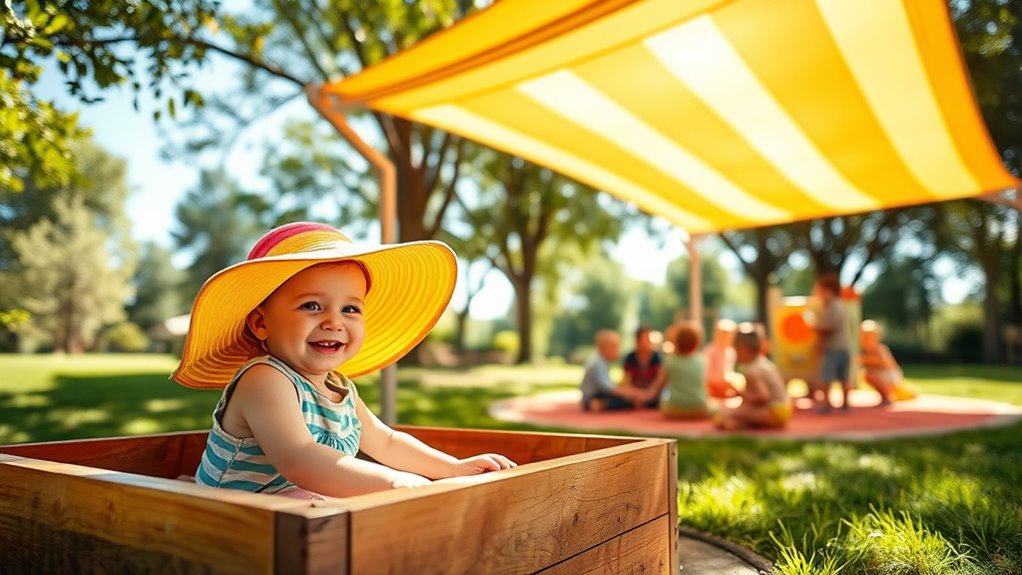
You can protect your little ones by choosing sun-protective structures like shaded pavilions or trees. Portable shade devices, such as umbrellas or pop-up tents, offer flexible options for outdoor play. Planning playtime during cooler parts of the day helps reduce sun exposure, keeping your kids safe and comfortable. Additionally, being aware of awkward moments that may happen outdoors can help you stay prepared and respond promptly to any unexpected situations. Recognizing dog breeds with calm and gentle temperaments can also ensure a safer environment for your children during outdoor activities.
Choose Sun-Protective Structures
Choosing the right sun-protective structures is essential for keeping babies and toddlers safe during outdoor play. Proper shade solutions help reduce UV exposure and keep young skin protected. When selecting structures, prioritize those that offer full coverage and UV protection. Look for materials that block harmful rays and provide consistent shade throughout the day. Consider permanent options like pergolas with UV-resistant fabric or well-placed trees that create natural shade. Portable structures, such as pop-up canopies, can also be effective if they provide ample coverage. Ensuring your chosen shade structures are sturdy and well-maintained helps maximize protection. Incorporating shaded play areas into your outdoor space can encourage healthier outdoor activities for children. Selecting appropriate materials that are durable and UV-resistant ensures long-lasting protection. Creating a safe outdoor environment also involves considering the placement of shade structures to avoid areas with reflected UV rays. Additionally, choosing structures with UV-blocking fabric can significantly enhance protection against harmful rays. Using natural shade sources like trees not only provides effective protection but also adds to the aesthetic appeal of your outdoor space. By creating a safe, shaded environment, you’ll give your little one a comfortable outdoor space while minimizing the risk of sunburn and long-term skin damage.
Use Portable Shade Devices
Portable shade devices offer flexible options for creating quick, effective shelter during outdoor play. With portable shade and sun shelters, you can easily set up shaded areas wherever your little one plays. These devices are lightweight, easy to transport, and quick to assemble, making them ideal for parks, beaches, or backyard playdates. Using sun shelters helps protect your baby or toddler from direct sun exposure, reducing the risk of sunburn and overheating. Look for models with UPF fabric and UV protection to maximize safety. Portable shade devices also provide a comfortable, shaded space where your child can rest and cool down. Incorporating UV protection into your outdoor routines ensures your child’s safety from harmful rays. Moreover, choosing appropriate shade options can enhance the effectiveness of sun protection for your little one. Additionally, maintaining a consistent routine can help your child feel more secure during outdoor activities. By incorporating these sun shelters into your outdoor routine, you ensure your child stays protected while enjoying outdoor activities.
Schedule Playtime Carefully
To protect your little one from the sun’s harsh rays, schedule outdoor playtime during the cooler parts of the day, such as early morning or late afternoon. This helps reduce their exposure to intense sunlight and minimizes the risk of sunburn. When planning outdoor activities, make certain the play area offers adequate shade and shelter to promote playground safety. You can set up portable shade devices or use natural shade from trees. Remember, sunscreen needs reapplication every two hours or after sweating or swimming to maintain protection. Keep an eye on your child’s behavior and skin, and encourage breaks in shaded areas. Additionally, understanding UV protection can help you make informed decisions about outdoor safety. These steps help create a safer outdoor environment and ensure your toddler can enjoy playtime without unnecessary sun exposure.
Recognizing and Preventing Sunburn in Young Children
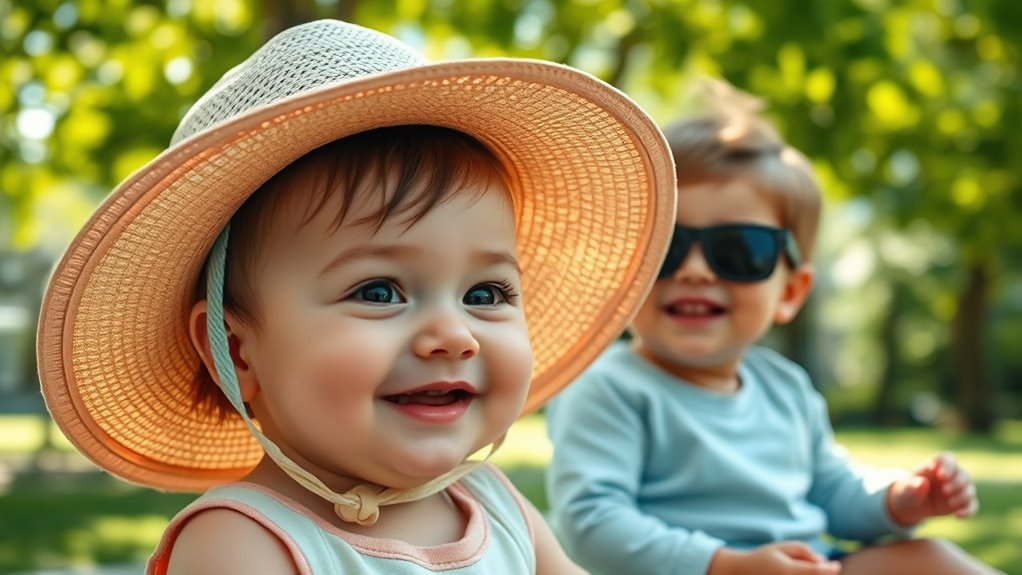
You need to watch for signs of sunburn, like redness or tenderness, so you can act quickly. Knowing when your child is most vulnerable to sun exposure helps prevent burns before they happen. If your little one does get sunburned, using cool compresses and soothing lotions can bring relief and support healing. Additionally, applying broad-spectrum sunscreen regularly can help protect sensitive young skin from harmful UV rays. Being aware of Kia Tuning options can also help ensure your child’s safety by maintaining your vehicle’s optimal performance and reliability during outdoor activities.
Signs of Sunburn
Recognizing the signs of sunburn early is essential for preventing discomfort and potential health risks in young children. Look for classic sunburn symptoms such as red, tender skin and warmth when touched. You might notice peeling or blistering in more severe cases, indicating skin damage. Early detection helps you act quickly to soothe your child and minimize further harm. Keep an eye out for these indicators:
- Redness and inflammation on exposed skin
- Pain or fussiness when touched or moved
- Swelling or blister formation
Being attentive to these signs allows you to take prompt steps like applying cool compresses, moisturizing, and keeping your child out of the sun. Recognizing sunburn symptoms early is key to preventing long-term skin damage and ensuring your child’s comfort.
Timing of Exposure
Timing is crucial when it comes to protecting young children from sunburn, as their skin is especially sensitive to UV rays. The sun’s intensity peaks during peak hours, typically between 10 a.m. and 4 p.m., so avoiding outdoor activities during these times reduces exposure risk. Seasonal changes also impact UV levels; summer months have stronger rays, requiring extra caution. Keep in mind that even on cloudy days, UV rays can penetrate and cause harm. Planning outdoor playtimes early in the morning or late in the afternoon helps minimize UV exposure. Regularly checking the sun’s position and UV index forecasts allows you to make smarter decisions about when to be outside. Proper timing is a simple yet effective way to protect your child’s delicate skin from sunburn.
Soothing Sunburned Skin
Sunburns can develop quickly in young children, making it essential to identify and soothe affected skin promptly. When you notice a sunburn, keep your child comfortable by applying gentle massage to the area, which can help improve circulation and reduce discomfort. Use cooling compresses to calm inflamed skin and lower heat. Be sure to avoid harsh lotions or perfumes that may irritate sensitive skin.
- Keep the child in a shaded, cool environment
- Offer plenty of fluids to prevent dehydration
- Dress them in loose, breathable clothing to avoid further irritation
Always monitor for signs of severe sunburn, like blistering or fever, and seek medical advice if needed. Proper care helps soothe sunburned skin and promotes healing.
Hydration and Cooling Strategies for Hot Days

On hot days, keeping your baby or toddler properly hydrated and cool is essential to prevent heat-related illnesses. Offer frequent sips of water or electrolyte drinks, especially during outdoor play. Use cooling techniques like shaded areas, fans, or damp cloths on their neck and wrists. To visualize effective hydration and cooling, consider this table:
| Hydration Tips | Cooling Techniques | Signs to Watch |
|---|---|---|
| Offer liquids often | Use a cool, shaded spot | Excessive sweating |
| Include hydrating foods | Dampen cloths or towels | Irritability |
| Limit sugary drinks | Fan or air circulation | Fatigue or dizziness |
These simple steps help keep your little one comfortable and safe during hot days.
Using Sun Hats and Accessories for Extra Defense
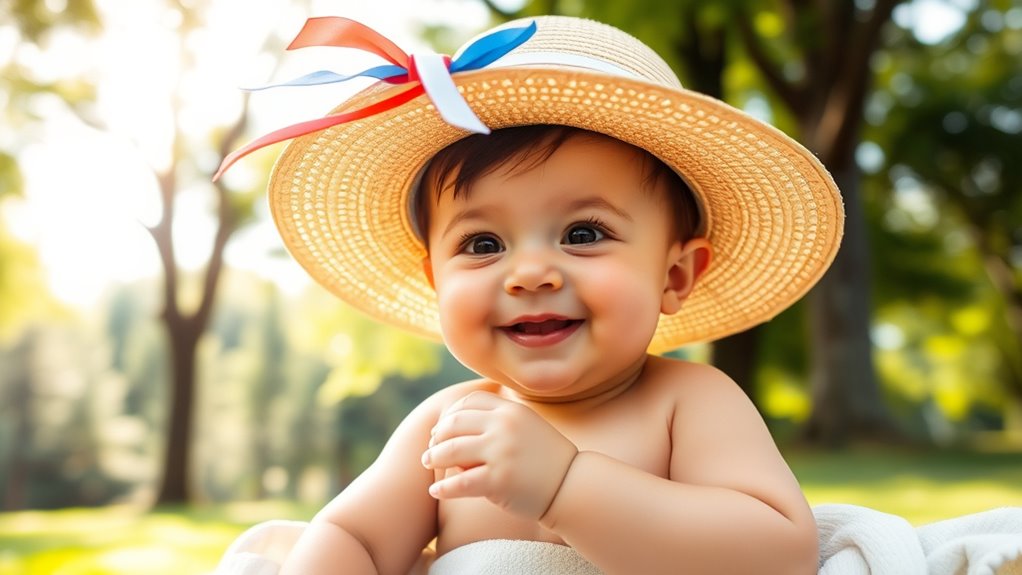
Adding sun hats and accessories to your baby or toddler’s outdoor gear provides an extra layer of protection against harmful UV rays. Choosing the right sun hat styles is key—look for wide-brimmed hats that shield the face, neck, and ears. When selecting accessories, prioritize safety by ensuring they fit well and don’t obstruct vision or breathing. Consider hats made from breathable, UV-protective fabrics for comfort and effectiveness. Be mindful of accessory safety by avoiding items with small parts that could pose a choking risk. Keep an eye on the hat’s chin strap to prevent it from slipping off. Properly fitted, stylish sun hats and accessories help keep your little one cool and protected during outdoor adventures.
Educating Caregivers and Family Members on Sun Safety
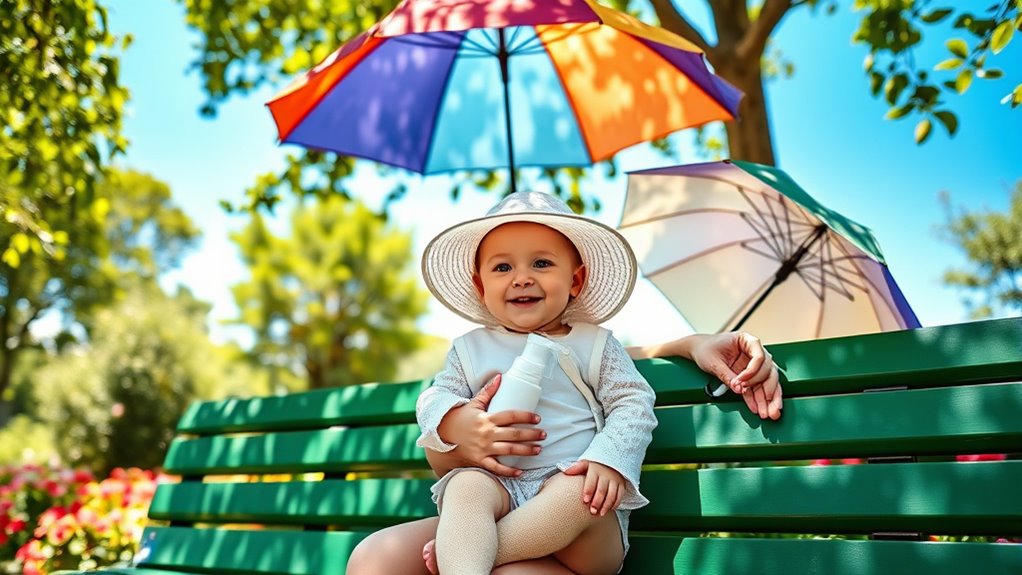
Since caregivers and family members play a crucial role in protecting children from harmful UV exposure, it’s essential to provide them with clear, practical information about sun safety. Sun safety education helps increase caregiver awareness of the risks and effective protective measures. You should inform them about the importance of applying broad-spectrum sunscreen, dressing children in protective clothing, and seeking shade during peak sun hours. Encourage regular check-ins to reinforce safe habits and model good behavior. By raising caregiver awareness, you empower those responsible for children’s well-being to make informed decisions outdoors. Clear guidance ensures everyone understands how to minimize UV exposure and protect young skin. Ultimately, well-informed caregivers create a safer environment, reducing the risk of sun damage and fostering lifelong sun-safe habits.
Frequently Asked Questions
When Is the Best Time of Day for Outdoor Play With Babies?
You should plan outdoor play during the early morning or late afternoon when the sun isn’t at its peak. During peak sun hours, typically between 10 a.m. and 4 p.m., the UV rays are strongest, increasing your baby’s risk of sun damage. Seek shade spots whenever possible and limit direct sun exposure, especially during these hours. This way, you keep your little one safe while enjoying outdoor fun.
Are There Any Natural or Organic Sunscreens Suitable for Infants?
Did you know that mineral-based formulations with zinc oxide or titanium dioxide are often recommended for sensitive skin? When choosing natural or organic sunscreens for infants, look for organic options that contain these mineral ingredients. They provide effective protection without harsh chemicals. Always opt for broad-spectrum, SPF 30 or higher, and test a small patch first. These options are gentle, safe, and ideal for protecting your baby’s delicate skin outdoors.
How Often Should I Reapply Sunscreen on My Child?
You should reapply sunscreen on your child every two hours, especially if they’re swimming or sweating. Follow SPF guidelines to guarantee adequate protection, choosing a broad-spectrum sunscreen with at least SPF 30. Keep in mind that natural or organic sunscreens may require more frequent reapplication, so monitor your child’s skin and reapply promptly after any water exposure or towel drying. Staying vigilant helps keep their delicate skin safe from harmful UV rays.
What Are Signs of Heat Exhaustion in Young Children?
You should watch for heat-related symptoms like heavy sweating, weakness, dizziness, or nausea in your young child, as these are signs of heat exhaustion. Dehydration signs include dry mouth, lack of tears, and infrequent urination. If you notice any of these, move your child to a cooler place, encourage fluids, and seek medical attention if symptoms worsen. Staying alert helps keep your child safe in hot weather.
Can Certain Clothing Materials Offer Better Sun Protection Than Others?
Did you know that some clothing materials provide better sun protection? UV resistant fabrics are designed specifically to block harmful rays, offering up to 50+ SPF protection. Breathable clothing made from lightweight materials keeps your child comfortable while shielding their skin. Choosing these fabrics over regular cotton or polyester guarantees your little one stays safe and cool outdoors, making sun safety easier and more effective for you.
Conclusion
By following these sun safety tips, you can shield your little one’s delicate skin from harm while enjoying the outdoors. Remember, protecting your baby or toddler isn’t just a modern concern—think of it as a timeless act of caring, like tending a cherished garden. So, stay vigilant, plan wisely, and make sun safety a priority, ensuring your child’s outdoor adventures are safe, fun, and full of sunshine without the burn.


